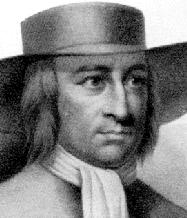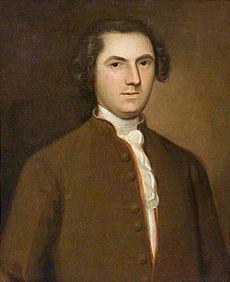Cary's Rebellion facts for kids
Cary's Rebellion was an important uprising in colonial North Carolina in 1711. It happened because Thomas Cary, a leader at the time, refused to give up his position to Edward Hyde. This rebellion was part of a long-standing disagreement between different religious and political groups in the northern part of the Carolina colony. These groups were mainly the Quakers, who supported Cary, and the followers of the Church of England, who supported Hyde.
Contents
Understanding the Colonial Past
At that time, the Carolina colony was a huge area, stretching from what is now Florida all the way to Virginia. However, traveling between the northern parts and the main government seat in Charleston was very difficult. Because of this, a special leader called a deputy governor was chosen for the northern section. This deputy governor could make many decisions on their own.
Early in its history, Carolina offered religious freedom. This made it a welcoming place for Quakers, who faced unfair treatment in England and other colonies. George Fox, the founder of Quakerism, even visited the Albemarle Settlements in northern Carolina in 1672. Over the years, Quakerism grew strong in the area. Quakers even held important government roles, including John Archdale, who became Governor of Carolina in 1694.

In 1699, Henderson Walker became the Deputy Governor of North Carolina. He was a strong supporter of the Church of England. He introduced new rules that made the Church of England the official religion of the colony. He also passed a law called the Vestry Act, which meant everyone had to pay a tax to support this official church, no matter their own faith.
When Queen Anne became the ruler, all colonial officers had to renew their loyalty by taking an oath. Quakers, because of their beliefs, do not swear oaths. They had always shown their loyalty by simply affirming it. But this time, their practice was not allowed, and all Quakers lost their government jobs. Over the next ten years, the differences between the Quaker party and the Church party became much stronger.
Thomas Cary's Time as a Leader
Thomas Cary was related to the former Quaker Governor of Carolina, John Archdale. However, when Cary first became Deputy Governor of North Carolina, he actually supported the Church party. He continued to keep Quakers out of government by strictly requiring them to take the oath.
The Quakers and some other unhappy Anglicans sent a representative to the Lords Proprietors in England. These "Lords Proprietors" were the owners of the Carolina colony. They decided to remove Cary from his leadership role. After Cary went back to South Carolina, William Glover took over as the acting Deputy Governor. But Glover also continued the policy of requiring oaths.
In 1707, Cary returned. This time, he supported the Quakers and others who disagreed with Glover. He also championed the interests of the town of Bath, on the Pamlico Sound, against the Albemarle government, which was centered near present-day Edenton. In 1708, Cary and his supporters managed to win an election and remove Glover. Glover then went to Virginia and made serious accusations against Cary. Cary then removed the oath requirement and allowed Quakers back into government. So, from 1708 to 1710, Cary and the Quakers were in charge. Cary also lowered the quit-rents for Bath County. These were like a land tax paid for royal land grants. However, Cary's government was not officially approved by the Lords Proprietors, so it didn't have full legal standing.
The Uprising Begins
While "Cary's Rebellion" can refer to the whole period of disagreement, it usually describes the events of 1711. This was when the Lords Proprietors chose Edward Hyde to become the new Deputy Governor, and Cary refused to accept it.

Hyde arrived in North Carolina in January 1711. He had letters from the Lords Proprietors and was supposed to get his official approval from the Governor of Carolina. However, the Governor had passed away before Hyde arrived, so his claim to the Deputy Governorship wasn't fully official yet.
Even so, Cary and the Quaker party were initially willing to let Hyde take over. But when Hyde clearly started to favor the Anglican party, Cary changed his mind. He refused to recognize Hyde until Hyde could show his full official approval, claiming that he, Cary, was still the legal governor.
Hyde declared that Cary was openly rebelling. He gathered about 150 armed men to go to Bath and arrest Cary. Cary fled from his home to a nearby plantation (possibly that of former governor Robert Daniell). This plantation was fortified with cannons and defended by several dozen of Cary's supporters. On May 29, after failing to reach an agreement, Hyde decided to attack. But he and his men were forced back after a short fight.
On June 30, 1711, Cary, using his armed ship, began an attack on Hyde and his council at Colonel Thomas Pollock's home. Hyde's followers had only 60 men and two cannons. Things looked bad for them when two groups from Cary's ship headed for shore. But at that moment, a lucky shot from one of Hyde's cannons hit Cary's ship, damaging its mast. This scared Cary's forces so much that they quickly sailed away.
But Cary wasn't ready to give up. With the help of a friend from England, Richard Roach, he built a fort on an island in the Pamlico and started gathering a brand new army. For a little while, it looked like Cary might win.
The governor of Virginia, Alexander Spottswood, decided to help Governor Hyde. He got his militia army ready to march into North Carolina. He also immediately sent a group of royal marines—these were special soldiers who worked for the King of England himself.
The Virginia army never even had to fight. Just the news that the royal marines were coming was enough to scare Cary's followers. They were okay with fighting Hyde, but they were too afraid to fight soldiers who served the King. Attacking the King's soldiers would be an act of treason, a very serious crime. Cary himself fled. He was arrested and sent to England for trial. He was released after about a year and returned to live peacefully in Bath.
What Happened After Cary's Rebellion?
During the years from 1708 to 1711, the disagreements in government greatly weakened the colonists in North Carolina. The Tuscarora War, a major conflict with Native Americans, began in September 1711. The confusion and division caused by Cary's Rebellion made it harder for the colonists to respond effectively. A drought and a yellow fever outbreak also added to their problems.
Cary's Rebellion also marked the end of the Quakers' influence in North Carolina's government. After the rebellion, they were mostly kept out of political roles.

